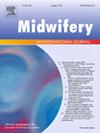Dutch midwives’ views on father-involvement practices
IF 2.6
3区 医学
Q1 NURSING
引用次数: 0
Abstract
Background
Midwives are uniquely positioned to engage fathers already prenatally and facilitate an equal transition into parenthood for both parents. However, they may face barriers hindering their investment in involving fathers.
Aim
The aim was to investigate barriers and facilitators midwives experience when implementing two father-involvement practices 1) involving fathers in antenatal and postnatal care and (2) encouraging parental conversations about future work/care divisions.
Methods
Study 1 utilized a World Café with twelve midwives to identify barriers and facilitators, across motivation, opportunity, and ability. Study 2 used a Q-methodology with 31 midwives to assess these factors' relative importance and identify distinct viewpoints.
Findings
The World Café revealed that midwives are motivated to involve fathers, primarily because they anticipate positive outcomes for parents and infants. Key barriers included a lack of time, finances, and educational resources. The Q-study identified that midwives could be clustered in two profiles reflecting different perspectives on the ranking of barriers to involving fathers in prenatal care. The "Educationally Constrained Midwife” lacks knowledge, educational materials, and training, while the "Resource Constrained Midwife" is hindered by time and financial constraints. For encouraging parents to discuss the future task division, only one profile was identified showing that midwives were motivated to incorporate this extra task if they receive additional time, finances, training, and educational materials to share with parents.
Conclusion
Addressing educational and resource barriers is crucial for enhancing father-involvement by midwives. Interventions tailored to these profiles can support midwives in adopting practices promoting father-involvement, potentially improving family outcomes and advancing gender equity in caregiving responsibilities.
荷兰助产士对父亲参与做法的看法。
背景:助产士在让父亲参与产前活动和促进父母双方平等过渡到父母身份方面具有独特的优势。目的:本研究旨在调查助产士在实施以下两项父亲参与实践时遇到的障碍和促进因素:(1)让父亲参与产前和产后护理;(2)鼓励父母就未来工作/护理分工进行对话:方法: 研究 1 采用世界咖啡馆的方式,与 12 名助产士一起,从动机、机会和能力等方面确定障碍和促进因素。研究 2 对 31 名助产士采用 Q 法评估这些因素的相对重要性,并确定不同的观点:世界咖啡馆 "揭示了助产士让父亲参与进来的动机,主要是因为她们期望为父母和婴儿带来积极的结果。主要障碍包括缺乏时间、资金和教育资源。Q 研究发现,助产士可分为两种类型,反映了她们对父亲参与产前护理的障碍排序的不同观点。受教育限制的助产士 "缺乏知识、教材和培训,而 "受资源限制的助产士 "则受到时间和经济限制的阻碍。在鼓励父母讨论未来的任务分工方面,只有一种情况表明,如果助产士获得额外的时间、资金、培训和教育材料与父母分享,她们就会主动加入这项额外的任务:解决教育和资源方面的障碍对于提高助产士的父亲参与度至关重要。针对这些情况采取的干预措施可以支持助产士采取促进父亲参与的做法,从而改善家庭成果并促进照顾责任方面的性别平等。
本文章由计算机程序翻译,如有差异,请以英文原文为准。
求助全文
约1分钟内获得全文
求助全文
来源期刊

Midwifery
医学-护理
CiteScore
4.50
自引率
7.40%
发文量
221
审稿时长
13.4 weeks
期刊介绍:
Midwifery publishes the latest peer reviewed international research to inform the safety, quality, outcomes and experiences of pregnancy, birth and maternity care for childbearing women, their babies and families. The journal’s publications support midwives and maternity care providers to explore and develop their knowledge, skills and attitudes informed by best available evidence.
Midwifery provides an international, interdisciplinary forum for the publication, dissemination and discussion of advances in evidence, controversies and current research, and promotes continuing education through publication of systematic and other scholarly reviews and updates. Midwifery articles cover the cultural, clinical, psycho-social, sociological, epidemiological, education, managerial, workforce, organizational and technological areas of practice in preconception, maternal and infant care.
The journal welcomes the highest quality scholarly research that employs rigorous methodology. Midwifery is a leading international journal in midwifery and maternal health with a current impact factor of 1.861 (© Thomson Reuters Journal Citation Reports 2016) and employs a double-blind peer review process.
 求助内容:
求助内容: 应助结果提醒方式:
应助结果提醒方式:


